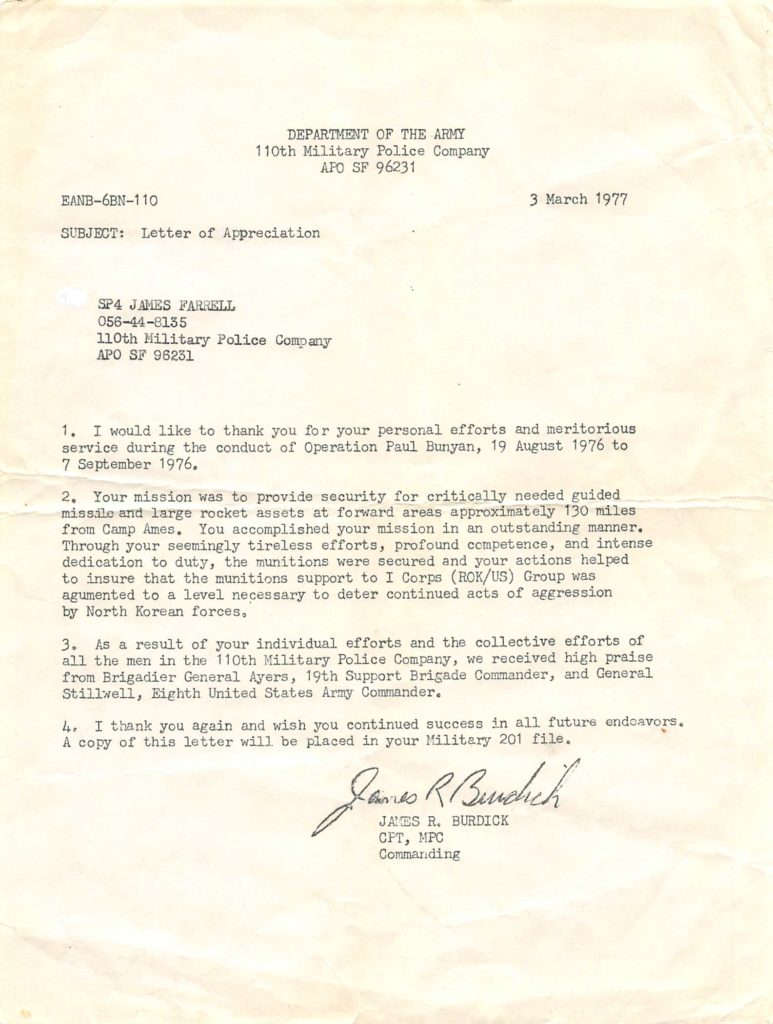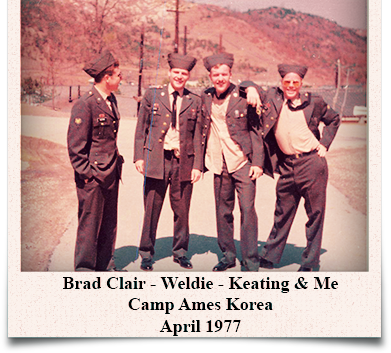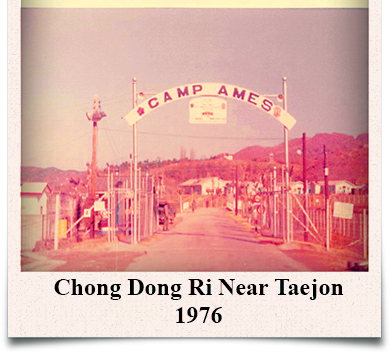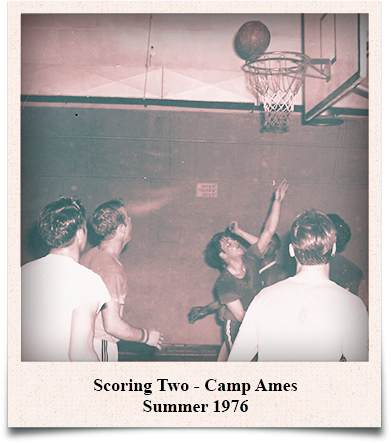
110th Military Police Company
South Korea 1976
For those of us who served in South Korea in 1976, we have two chapters of our experience. One is the pride of accomplishing our mission to protect the amazing people of South Korea while getting to know and love them. Our second chapter in August 1976 was almost going to war over a tree. A brutal unprovoked murder of two American Officers on August 18, 1976, to be known as the Ax Murder Incident had the United States on the brink of war with North Korea. This is my story of proudly serving with the 110th Military Police Company at Camp Ames Korea during this period.
After serving a year at Fort Lewis Washington for the 9th MP Company I arrived in Korea in April 1976. I was assigned to the 110th Military Police Company at Camp Ames Korea. Our assignment was to provide security and support for the 6th Ordnance Battalion. Camp Ames was a missile storage facility and at this time included Nuclear munitions. Settling in was easy and fun, I became best friends with Brad Clair, and we would explore the entire country together, and do the things normal young soldiers do. Of course, that included drinking, having fun and getting to know the beautiful young ladies living near the base. Far from everyone’s minds were the disaster of the Vietnam War, although we all knew the American’s public disdain for the conduct of the war, which was fair, but also the lack of respect and utter disdain for returning soldiers which were not fair.
Our duties were to man guard towers to protect the missile silos and provide escort and security for movement of munitions. Besides Brad Clair, other members of our crew were Weldie, Keating, Walker, Pumprey, Kenny, Jones and Borgeson. SP4 Borgeson was one of the dog handlers, his dog was appropriately named “Killer”. Trust me you did not want to be inside the security gates with Killer on the loose. He was trained to subdue and kill if necessary. We all hung out together and took many trips exploring most of South Korea.
The area of the munitions silos was surrounded by guard towers and security checkpoints. Our main function was to climb up these guard towers, watch for anything out of the ordinary to happen, and provide a warning to any attack. A somewhat boring, but necessary assignment. One man towers left you alone with only your M-16 rifle and a radio. In two-man towers, you had a partner with your M-16’s and an M-60 machine gun. The towers had kerosene heaters, which often did not work, or ran out of kerosene, needless to say, we spent many a very cold night manning those towers. In the two-man towers, many true and fabricated stores were swapped about your life back home. In the one-man towers, you were left to talk to yourself. All through it all, our morale was high and we became brothers that would look out for each other.
In October 1976 Brad and a few of us decided to visit the southern port city of Pusan. We had heard it was beautiful and took a train there. Upon arriving we took a taxi to the main part of the city. Well, I guess we were all dumb 18 to 19-year-old kids and had no idea what to expect. Pusan was a big port for the US Navy, and supplied goods, services, including the oldest vice to the Navy when the sailors were in port. The interesting part of our particular trip was that most of the Navy was out to sea and there were few sailors or soldiers in the city of Pusan. Well, what did that mean to us? We did not know. As the four of us were about to get out of the taxi, we started noticing young girls coming out of shops to look at us. What to make of this we did not know. As we paid the taxi driver the fare, more and more young girls came out of shops walking towards us. We all started looking around and gazed at each other with a look of disbelief. First, there were dozens, and they followed us as we walked down the block. Soon there were over 100 young girls walking at us at a fast pace. What the hell was going on we said to each other. We started a light jog, at this point there must have been over two hundred young girls and now they were running at us. What the ****? We had no idea what to do so we ran as fast as we could. It took 10 or 15 minutes, but we finally outran this onslaught. Finally, a Korean gentleman who spoke English told us what happened. You see, all of these girls were prostitutes, and with the Navy out at sea for a while, they had no clients and were desperate for business. When they saw us, they ran to be the first to catch us. I don’t know what would have happened if we stayed around, but pretty sure running was our best option. We laughed about this for quite some time, and I bet many of the guys remember it to this day.
One of our favorite activities was exploring and visiting the Korean farmers in the countryside. I must say the sight and smells of the Korean countryside fascinated us, and we were motivated to learn as much as possible about Korea’s people, culture, and traditions. Funny, rarely did the villagers speak much English, but somehow, we were able to communicate with each other. This was a favorite activity for Brad, Keating, Weldie and myself. On our visits, we would help them with their chores, talk and take pictures with their families, drink the Korean rice wine, and sometimes stay for a meal. I was not an adventurous eater and only once tasted Kimchi. We all felt we were getting to know the heart and soul of the Korean people and remember these times so fondly.
The very first time Brad and I went skiing was on a weekend pass. I don’t remember the location, but what we did was put on the skis, go up on the lift, go as fast as we could and fall. Then repeat this for hours. It was hysterical, adding to the confusion was that few of the people spoke English, but they sure enjoyed laughing at our futile attempts. At night we drank beer and wine with the locals until we went to sleep. Everyone seemed to love us, and we loved them, talking as best as we could to understand each other. Brad and I loved meeting the Korean people and would talk and drink with them for hours on end. Here we were 19-year old kids, making $400 @ month, being treated like kings.
Probably our most memorable and fun trip was an extended week-long pass, which we used to visit the capital city of Seoul. I don’t remember how many of us went, but it had to be at least 10. 10 young GI’s with money to spend and looking for fun, it get’s no better than that. We took the train to Seoul, upon arrival went looking for the taxi stand. For some reason Brad started wondering out on the busy road and you could see he was going to get hit by a car. Don’t know why I instantly ran and tackled him to the ground and grabbed him back to the sidewalk. I totally forgot about this, but recently reconnected with Brad and he reminded me saying I saved his life. I don’t think so, but at least our trip did not get off to a bad start.
Our trip to Seoul was non-stop partying, going to clubs, meeting so many Korean people. In Seoul it was more likely the locals would speak English. We loved meeting everyone and they loved meeting us. Many of our meals and drinks were paid for by the people we met, I think they were grateful we were half-way around the world to protect them. Meeting the Korean girls was fascinating, they wanted to know everything about us, and we were happy to tell our individual stories. I know we all left with memories that will keep in our minds for our lifetime. This was a great week, but the happiness would only last for a short time after our return to Camp Ames. A tragedy was about to hit the 110th Military Police Company.
Shortly after our return, on a pleasant day, we had finished our 24-hour shift manning the guard towers. I remember the day well, it was early afternoon, and everyone was goofing around without a care in the world. Suddenly several of our company officers came running into the barracks yelling “Quick! Stop what you’re doing! Get dressed for duty, ASAP!” We immediately understood that something terribly wrong had happened. We quickly complied, got dressed, got our weapons, and took over for the on-duty platoon. Brad, myself and our platoon members manned the towers. We manned all the towers except for one. At this tower, with no guard, we could see many of the officers looking frantic but still did not know what was wrong. It would not be until the end of our shift did we find out what had happened. A friend of mine in the original on-duty platoon had gone on guard duty that day and climbed up his tower with his rifle and equipment. When he got to the top, he put his M-16 in his mouth and pulled the trigger. Even if you have never seen what an M-16 bullet can do, you can probably still imagine the carnage.
My friend blew his brains out in the tower that day. We were all in shock, often speechless. The investigation was quick and intense: all of us in the 110th MP Company were interviewed for any bit of information on why our brother soldier had decided to end his life. Afterward, the Army provided counseling to help us cope with the sudden death of our brother in arms. We never did find out why he committed suicide: all we found out was that he had family or girl issues back home and was depressed. None of us saw him as depressed – I guess he hid it well. This was my first experience of the traumatic sudden death of a friend, and it stung hard. After a while, the pain went away, but writing about today it brings back the pain.
Operation Paul Bunyan – The Axe Murder Incident
The Brutal Ax Murders of Captain Bonifas & Lt. Barrett
The Korean Demilitarized Zone is a border established in 1953 to separate North and South Korea. The Joint Security Area is located along this border in Panmunjom, where, over the years negotiations and thousands of incidents have occurred. The Bridge of No Return separates the South from North and is located in the Joint Security Area. It is from this bridge that our POWs walked over to freedom at the end of the Korean War in 1953. In August 1976 an 80-foot tree was obstructing the view of a vital checkpoint at the mouth of the Bridge of No Return. On the morning of August 18, 1976, a 15-man US/South Korean task force was assigned to prune the tree to remove the obstruction. Leading the group of the task force were two American Officers, Captain Arthur Bonifas (Who was scheduled to rotate back to the US in 3 days) and 1st Lieutenant Mark Barrett. Unbeknownst to Captain Bonifas and his detail a few weeks before on August 6, 1976, South Korean soldiers had to abort an identical detail after being threatened by soldiers from The North Korean People’s Army (KPA).
On the morning of August 18th, the tree cutting detail mounted ladders and started the sawing and axing to prune the tree of the obstructed view. About twenty minutes later a North Korean officer Senior Lieutenant Pak Chul warned the detail to stop what they were doing. Lt. Chul said that Kim Il Sung (Founder of North Korea) personally planted the tree, nourished it and it was growing under his supervision. Lt. Pak was nicknamed “Bulldog” by the South Korean soldiers for his wild aggression. Captain Bonifas ignored his demand and instructed his crew to keep on working. The aggressive and agitative Lt. Pak, sent for a truck of over 20 North Korean soldiers armed with pipes and clubs. Lt. Pak again commanded the detail to stop cutting the tree but again was again ignored by Captain Bonifas, who turned his back to Lt. Pak. Lt. Pak, took off his wristwatch, wrapped in a handkerchief and stuffed into his pocket (to protect it from being stained or damaged), then yelled “migun ul chu gi ja” which translates to “Kill the US Aggressors”. The North Korean soldiers then attacked the detail with their weapons. In the melee some of the South Korean soldier’s loss their axes, which were quickly picked up by the North Koreans who used them in the attack. Lt. Pak Chul jumped on Captain Bonifas from his back knocking him to the ground, where he was beaten to death by at least 5 KPA soldiers. The attack was stopped when a smart soldier drove his 2 1/2 ton truck into the fight right over Captain Bonifas’s body to protect his brothers in arms. One South Korean Officer was killed and 8 other US/South Korean soldiers were injured during the Ax Murder Incident.
Lt. Barrett was not accounted for, pictures would reveal Lt. Barrett was last seen jumping over a retaining wall. Pictures of North Korean soldiers were observed going over this retaining wall with an ax, coming out after a few minutes and giving the ax to another soldier who would then go over the wall, stay a few minutes and so on to other soldiers. The North Koreans were actually taking turns hitting Lt. Barret’s body with the ax. Lt. Barrett would endure this horror and brutality for over an hour and surely must have known death was imminent. His mutilated body was somehow found alive but he died on route to medical treatment. Read the eyewitness recollection of SPF William Ferguson on the brutal Ax Murder of Lt. Barret – Lt. Barrett died a horrible and barbaric death at the hands of North Korean soldiers taking joy in their turns at axing his helpless body.
President Gerald Ford upgraded US forces in Korea to the DEFCON 3 readiness level, moving nuclear and conventional weapons to concrete bunkers and an aircraft carrier to Korean waters. Secretary of State Henry Kissinger recommended a swift bombing campaign of North Korea stating “North Korean blood must be spilled”, but President Ford wary just after the end of the Vietnam War opted for a strong show of force, which had less of a chance of starting a second war with North Korea.
President Ford called the incident “Vicious and unprovoked murder”, After three days it was decided to initiate Operation Paul Bunyan, a strong show of force to cut down the tree. On the morning of August 21, 1976, the entire area was put on high alert, and all in the Joint Security Area were prepared for conflict. North Korea prepared for conflict in the Joint Security Area by manning about 200 armed troops establishing two-man machine gunning positions and placed its entire nation on a military alert to guard against an invasion from the south. Three US B-52 bombers, a squadron of F-111 & F- Phantom fighter jets, 27 helicopters gunships, and other military equipment were in the air during the mission. Elements of the 7th Fleet, including the carrier USS Midway, rushed to Korean waters. Operation Paul Bunyan sent a team of 110 troops, 64 of whom were Korean taekwondo experts. The detail chopped down the tree with chains saws and axes in 42 minutes. All that was left was a six-foot-long stump to mark the position of the ax murder incident.
After the incident in a rare “one time only” moment Kim Il Sung express regret over the incident.

Captain Burdick you were a great leader and commander, for Brad, Weldie, Keating and myself it was an honor to serve under you.

Thanks to all the soldiers who participated in Operation Paul Bunyan in August 1976 the second Korean War was averted.
Photo Credit Patrick McGee, SMSgt, USAF (Ret) | Operation Paul Bunyan – The Ax Murder Incident
For Brad, myself and the 110th MP Company Operation Paul Bunyan required us to provide security during transport of guided missiles and large rocket assets to areas near the border about 130 miles from Camp Ames. We were told this is the real deal that war was imminent. We were being positioned for immediate action. The munitions would support I Corps to be ready to act on any aggression from North Korea during Operation Paul Bunyan. Our deployment period was from August 19 to September 7, 1976. Like everyone else deployed in Korea during this time, we were pissed about the murder of our two officers and ready for any orders received. Some guys did joke, “Shit we just missed Vietnam but made the second Korean War”. Like everyone else, our morale was sky high. Reading the current news about the never-ending aggression of North Korea always brings back memories of the Ax murder incident for me. For me and for many who were deployed in South Korea during this period we will never forget the memory of Captain Bonifas and Lt. Barrett, may they rest in peace.
On August 20, 1976, the bodies of Capt. Bonifas and Lt. Barrett was taken to Kimpo Airport for return to the States. At the airport, a ceremony was held during which Bonifas was promoted posthumously to major, and he and Barrett likewise were awarded Purple Heart and Joint Service Commendation medals.
On August 18, 1986, the base formerly known as Camp Kitty Hawk was renamed Camp Bonifas in honor of his memory. The six-foot stump of what remains of the tree is now is a plaque in memory of Captain Bonifas and Lt. Barrett.


































